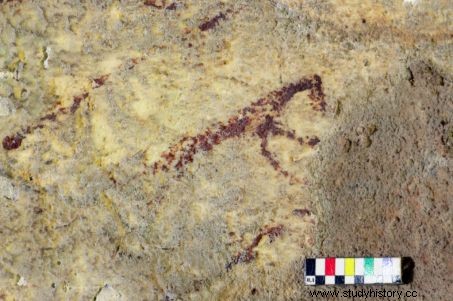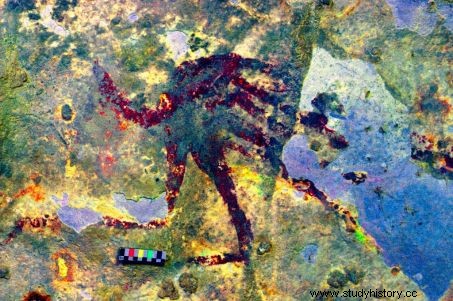A hunting scene, painted 44,000 years ago in present-day Indonesia, is said to represent "the oldest hunting scene in prehistoric art "known to date, according to researchers who signed a study published in the journal Nature .

Photo courtesy of Griffith University of oldest known hunting scene.
It would be the oldest known work of figurative art:a prehistoric hunting scene painted more than 40,000 years ago, whose half-human, half-animal representations were discovered in a cave in Indonesia.
A method to determine the minimum age of paintwork
On a panel 4.5 meters wide, we see six mammals (wild pigs and dwarf buffaloes) pursued by a group of hunters armed with spears and ropes, reports a study published on December 11, 2019 in Nature . These hunters are drawn with a human body but an animal head (bird, reptile, etc.) - figures called "therianthropes" by certain specialists. This monochrome painting was unearthed in 2017 on the limestone walls of a cave on the site of Leang Bulu Sipong, on the Indonesian island of Celebes, in a fairly degraded state. To date the painting, a team from Australia's Griffith University used a dating method that uses uranium-thorium on the mineral blisters (known as "popcorn") agglomerated on the painting. (This is a radiometric dating method which notably makes it possible to measure the age of certain carbonate formations).
According to the article's signers, the painting dates back to the Upper Paleolithic period and is "at least 43,900 years old ". Which makes it according to them "the oldest hunting scene in prehistoric art " known to this day. It would even be, "to (their) knowledge, the oldest work of figurative art in the world ". It would thus dethrone - still according to these authors - the ivory sculpture of a man with the head of a lion found in Germany, considered so far as the oldest representation of a therianthropic creature (40,000 years), explains the study By way of comparison, cave paintings in France from the Chauvet cave (Ardèche) date back around 37,000 years, those from Lascaux (Dordogne) around 18,000 years ago. In both cases, "it is about maximum ages because the dates are from the charcoal pigment and tell us when the tree died, not when the charcoal was used to draw “, explains to AFP the archaeologist Maxime Aubert. The method applied for the site of Leang Bulu Sipong makes it possible to determine a minimum age because “it precisely dates the mineral concretions which formed naturally on the painting “, details the researcher.

© RATNO SARDI / GRIFFITH UNIVERSITY / AFP
Indonesia:a cradle of cave art?
"This is the first time that such a detailed narrative has been identified with such an early period “, Welcome the researchers in a press release. The thin creatures representing the hunters, painted with dark red pigment, are simplified and very stylized, with for example elongated faces resembling muzzles. “The main components of a highly advanced artistic culture, including figurative art, narrative scenes and therianthropes, were present 44,000 years ago " in this region of Asia, underlines Maxime Aubert, who adds:"according to a received idea, rock art appeared in Europe, and consisted of abstract symbolic representations ".

© RATNO SARDI / GRIFFITH UNIVERSITY / AFP
This discovery, coupled with that of a 40,000-year-old figurative painting of a wild ox, found in 2018 on the island of Borneo, makes Indonesia "one of the most important regions in the world. to understand the beginnings of cave art and the evolution of modern human thought ", according to the researchers. These images of therianthropes could also be the first evidence of the human ability to "conceive things that do not exist in nature, a basic concept that underlies modern religion em> ", argues Professor Adam Brumm. This art could express "a spirituality based on a special bond between men and animals ", and this well before Europe, add the researchers. They take the opportunity to warn about the poor condition of the cave walls, which are deteriorating at high speed, threatening to erase the work. "It would be tragic that this ancestral art disappears in our lifetime, and yet this is what is happening. It is urgent to understand why ", they conclude.
